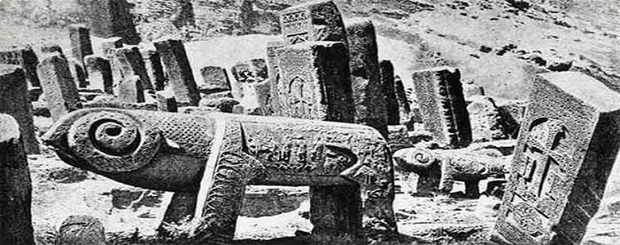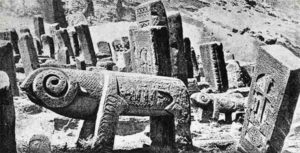
The Demolition of the Armenian Heritage in Azerbaijan – The Demolition of the Armenian Heritage in Azerbaijan
June 20, 2019 News, World:
The young Christian and democratic state of Artsakh continues to oppose Azerbaijan, a Muslim quasi-monarchist dictatorship of the Middle Eastern type, whose economy is based on oil production.
Since the late 1960s, Azerbaijan has been ruled by the Aliyev clan founded by Heydar Aliyev, a KGB general who, after being elected the first secretary of the Communist Party of Azerbaijan, ruled the Azerbaijan SSR in the 70s and 80s.
In 1993, two years after the declaration of independence of Azerbaijan, Heydar Aliyev organized a military coup and came to power, becoming the third president of the country.
When President Heydar Aliyev died in 2003, his only son, Ilham, became the leader of Azerbaijan. He was “elected” by juggling the voting results, as usual. Ilham Aliyev continued the tradition of the authoritarian rule of his father.
In his Azerbaijan, any manifestation of dissent is now suppressed: opposition parties are actually banned, there is no free press as such, the Internet is under control, and every year, dozens of people go to jail for criticizing the authorities or die under unclear circumstances.
Today, the main targets of the Aliyev regime in Azerbaijan are monuments of the Armenian historical and cultural heritage, hundreds of which are located in the west of Azerbaijan and in Nakhichevan. In 2006, Ilham Aliyev ordered the demolition of all Armenian churches, monasteries, and cemeteries in Nakhichevan.
Nakhichevan was recognized as part of the Armenian Republic by the governments of the Entente in 1919-1920 and by the Russian Bolsheviks in 1921. However, under the pressure of the Turkish government, Nakhichevan was transferred to the government of Soviet Azerbaijan by Soviet Russia.
In the spring of 2006, the large-scale demolition of architectural monuments and khachkars (Armenian stone crosses) located at the world-famous medieval cemetery in Julfa provoked protests from the international community. The world press compared Azerbaijani vandalism with the destruction of the Buddha’s monument in Afghanistan by the Taliban regime in 2001.
Two years before that, Ilham Aliyev had publicly urged Azerbaijani historians to rewrite history textbooks, eliminating all references to facts that are not directly related to the Azerbaijani (Turkic) historical heritage of their country.
This task is really not simple. Azerbaijanis are a relatively young ethnic community. Being descendants of the Turkic nomads who had migrated from Central Asia, the Azerbaijanis practically don’t have any tangible cultural trails in the territory of modern Azerbaijan.
Unlike Armenia, Georgia, and Iran (Persia), whose history and culture were formed during the period of antiquity, “Azerbaijan” as a geographical, political, and cultural unit appeared only at the beginning of the 20th century. Until 1918, the territory of the present republic had never been called Azerbaijan. This name instead belonged to a province of Persia, which bordered present Azerbaijan from the south and was populated mainly by Turkic Persians.
In 1918, after long meetings and consideration of several alternative proposals, the Turkic leaders of the Transcaucasia decided to declare their own state in the territory of the former Baku and Elisabethpol Governorates of Russia and name it Azerbaijan.
This immediately caused a keen diplomatic reaction from Tehran which accused Baku of appropriating Persian historical and geographical terminology. The League of Nations refused to recognize and accept the self-proclaimed state of Azerbaijan.
In order to demonstrate the absurdity of this decision, suppose that the Germans form a national state for themselves and call it Burgundy (a French province) or Venice (an Italian province), thus causing the protests of France or Italy and the United Nations.
Until the 1930s, the concept of “Azerbaijanis” as such did not exist. It appeared due to the so-called “indigenization” – a Bolshevik project aimed, in particular, at creating national identity for many ethnic groups that did not have a self-name.
Among them were the Turks of Transcaucasia who were referred to as “Caucasian Tatars” (along with the “Volga Tatars” and “Crimean Tatars”) in royal documents. Until the 1930s, the “Caucasian Tatars” called themselves either “Muslims” or defined themselves as members of tribes, clans, and urban communities such as Afshars, Padars, Sarydzhaly, Otuziks, etc.
At the beginning, however, the Kremlin authorities decided to call Azerbaijanis “Turks.” This term was used to designate the population of Azerbaijan during the 1926 All-Union Census. Moscow Bolshevik ethnographers also invented standard names for “Azerbaijanis” based on Arabic names with the addition of a Slavic ending “-s” and invented an alphabet for their language.
Today, Azerbaijani historical revisionism and cultural vandalism are openly condemned by Russian and international scientists and politicians. However, the Baku regime ignores international public opinion and continues to treat Armenian historical and cultural monuments in the territory of Azerbaijan as a direct threat to Azerbaijani statehood.
Julfa – History of Armenian khachkars destruction by Azerbaijan

allinnet.info/news/the-demolition-of-the-armenian-heritage/
